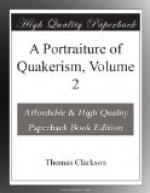The salvation of the Eight by water, and the baptism of John, were both types of the baptism of Christ. John was sent expressly before Jesus, baptizing the bodies of men with water, as a lively image, as he himself explains it, of the latter baptizing their souls with the Holy Ghost and with fire. The baptism of John, therefore, was both preparative and typical of that of Christ. And it is remarked by the Quakers, that no sooner was Jesus baptized by John with water in the type, than he was, according to all the Evangelists, baptized by the [161] Holy Ghost in the antetype. No sooner did he go up out of the water, than John saw the Heavens opened, and the spirit of God descending like a dove, and lighting upon him. It was this baptism of Jesus in the antetype which occasioned John to know him personally, and enabled him to discover him to others. The baptism of John, therefore, being a type or figure under the law, was to give way, when the antetype or substance became apparent. And that it was to give way in its due time, is evident from the confession of John himself. For on a question which arose between some of John’s disciples and the Jews about purifying, and on a report spread abroad, that Jesus had begun to baptize, John says, [162] “He (Jesus) must increase, but I must decrease.”—This confession of John accords also with the following expressions of St. Paul: [163] “The Holy Ghost this signifying, that the way into the Holiest of all was not yet made manifest, while as the first tabernacle was yet standing, which was a figure for the time then present,”—which stood only in meats and drinks, and divers washings, and carnal ordinances imposed on them until the time of reformation.
[Footnote 161: Mat. 3. 16.—Mark 1. 10.]
[Footnote 162: John 3. 30.]
[Footnote 163: Heb. 9. 8. 9. 10.]
SECT. IV.
Quakers show that the baptism, included in the great commission, which appears not to be the baptism of John, is the baptism of Christ, from a critical examination of the words in that commission—Way in which the Quakers interpret these words—This interpretation confirmed by citations from St. Mark, St. Luke, and St. Paul.
Having attempted to show, according to the method of the Quakers, that the baptism of John is not the baptism included in the great commission, I shall now produce those arguments, by which they maintain that that baptism, which is included in it, is the baptism of Christ.
These arguments will be found chiefly in a critical examination of the words of that commission.
To enable the reader to judge of the propriety of their observations upon these words, I shall transcribe from St. Matthew the three verses that relate to this subject.
[164] “And Jesus came and spake unto them, saying, All power is given unto me in Heaven and in earth. Go ye, therefore, and teach all nations, baptizing them in the name of the Father, and of the Son, and of the Holy Ghost; teaching them to observe all things whatsoever I have commanded you. And lo, I am with you alway, even unto the end of the world.”




